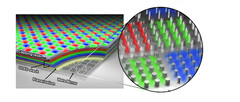A new paper in the journal Science describes a new and revolutionary type of OLED panel. It may boost the material's pixel counts, brightness and general quality by a significant margin, thanks to a Samsung Advanced Institute of Technology (SAIT) scientist's idea to apply the latest in photonics for solar panels
This research has resulted in the development of a new kind of reflective bottom layer for these devices. They are made of metal processed to exhibit a specific texture at the nanoscopic level. These “corrugations” harness recent breakthroughs in the understanding of how light behaves at the same scale
This, according to Stanford physics researcher Mark Brongersma, includes an ability “to flow around objects such as water”. In other words, the new metal “backplate” (or “optical metasurface”, as it is technically known) should deliver light to the rest of a given solar panel with as much efficiency as possible.
When Won-jae Joo from SAIT attended a presentation on this concept at the same university, he saw that it might have potential for OLED technology as well. Accordingly, Brongersma, Joo and several other SAIT, Stanford and Hanyang University (in Seoul, South Korea) scientists collaborated on a project to develop a new form of the panel type that integrated the same metasurface.
The group reported that the resulting panel had advantages over conventional displays such as those found in the high-end phones or TVs of today. For example, this material may require pixels placed at different “heights” within a panel as it is fabricated, according to the different wavelengths of light they emit to produce their colors.
The new “meta-OLED” removes the need for this, however, thus giving it an edge in terms of the ease and economy of producing it. However, and probably more importantly, the experimental panel's pixels had a “higher color purity and a twofold increase in luminescence efficiency” compared to regular OLED. These results also translated to a density of about 10,000 pixels per inch (ppi). For context, even the Galaxy Note 20 Ultra has one of just under 500 ppi.
On the other hand, the Science paper's authors base these findings on a relatively small prototype panel. However, SAIT appears confident that it can be scaled up quickly and easily. Therefore, we might see this ultra-dense, color-rich and bright new form of OLED in real-world devices fairly soon.
Sale off now on Amazon - Alienware Curved 34 inch WQHD 3440 x 1440 120Hz Monitor




















